- All
that you wanted to know about and see in this heritage and historic town of
Orchha.
Be it 2008 or January 2020 Orchha is still lovely. During a trip got to meet Vandna, a travel guide, who also runs a home-stay and cooking classes. Vandna tells you about the beauty and history of Orchha with a little bit of help from me (Editor). In order to make piece comprehensive some matter taken from other sites.
Only
19 kms from Jhansi, Orchha has a rich legacy of the time gone by as it is
captured in stone and frozen in time. The monuments built by its Bundela rulers
in the 16th and 17th centuries retain much of their pristine perfection. Also
strewn around the area are little shrines and memorials, each with its own
poignant history that contribute to the nostalgic beauty of Orchha.
Comparisons are drawn between heritage towns of Hampi and Orchha. The comparison is not apt because Orchha is a living town which Hampi is not. Further Orchha flourished because of its “strategic defensive location, religious importance and valor and exemplary diplomacy of the Bundeli rulers of Orchha in the given geopolitical environment.”
Brief Background
Orchha
is a medieval city built during the 16th century by Bundela Rajput Chieftain
Rudra Pratap. It was his second capital, the first being Gadkurar 55 kms away.
He came to Orchha for hunting and saw a tiger chasing a cow. In an effort to
save the cow he saw all of Orchha, loved the place. It also had a river flowing
by hence decided to make Orchha his capital.
The word Orchha means ‘hidden’ and verily the town stands for it. “Orchha was an ideal place to build a capital as the town is sheltered by thick forest, which is probably the reason that these age-old monuments still exist in excellent condition, despite there being no major preservation efforts.”
Blood, war and sacrifice are the keywords to describe the Rajput Bundela dynasty that ruled Orchha for over two centuries starting 1531 A.D. The word Bundela means, ‘the offerer of the drops (of blood)’. Sacrifice is
the very essence of Bundela life and its history amplifies this fact.
Madhukar Shah ruled from 1555 to 1592 while Vir Singh Deo ruled from 1605-1627. Vir Singh developed the city during the 17th century. He got close to Mughal heir prince Salim. On Salim’s suggestion he ambushed and murdered Akbar's closest counsellor Abu' Fazal in 1602. Although Akbar's army invaded Orchha the same year, and Singh had to flee he was rewarded when Salim occupied the throne with name Jahangir.
In
1606 Jahangir visited Orchha, spent a night, for which the king made Jahangir
Mahal. Vir Singh also made the Datia Palace for Jahangir but the king did not
halt there. Later the Bundelas shifted their capital from Orchha to Tikamgarh.
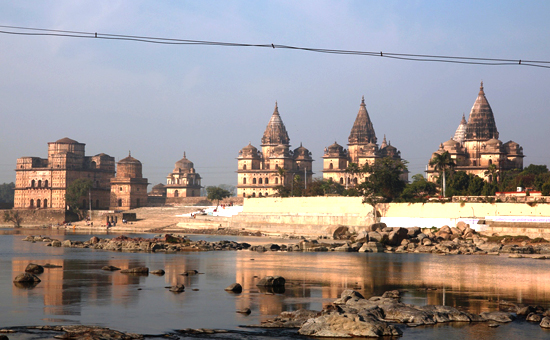 Chhatris of Bundel rulers.
Chhatris of Bundel rulers.
What to see in Orchha?
Orchha
is known for its Chhatris or Cenotaphs of the Bundel rulers. They are located at Kanchan Ghat on the banks of river Betwa. Best time to visit is early morning (for their reflection in the river) and at sunset for a golden glow. Vir Singh Deo's chhatri is set slightly apart.
Ram Raja Temple: Rani Ganesh Kunwari (Sri Ram Bhakt), wife of Madhukar Shah (Krishna Bhakt) brought Sri Ram’s murti from Ayodhya.
According to local tradition the queen went to Ayodhya to bring Sri Ram, for which she did tapasya-penance on the banks of river Saryu. Since she was unable to do so she chose to drown in the river. Sri Ram saved her and agreed to go with her to Orchha on three conditions. One, take me via Padyatra (took the queen twenty eight months and twenty-seven days to reach Orchha from Ayodhya). Two, when I go to Orchha I will be king. Three, wherever you make me sit in Orchha I will not move from there.
Meanwhile the king was making the Chaturbhuj Temple for Sri Ram. The temple was built in such a manner that the queen could see Sri Ram from her palace’s window. When the Queen reached Orchha, the Chaturbhuj temple was incomplete so she decided to place the murti of Sri Ram in the rasoi-kitchen of Rani Mahal that was next to the temple. Since one of Sri Ram’s conditions was that once placed, he would not move Rani Mahal became Ram Raja Mandir.
 Ram Raja Mandir.
Ram Raja Mandir.
Chaturbhuj Temple: The temple is like a beacon in Orchha and
can be seen from every corner. A tall shikhara (spire) rises over the sanctum. The
four hundred year old temple is nearly eight stories high, in a place where
contemporary buildings rarely raise higher than one level.
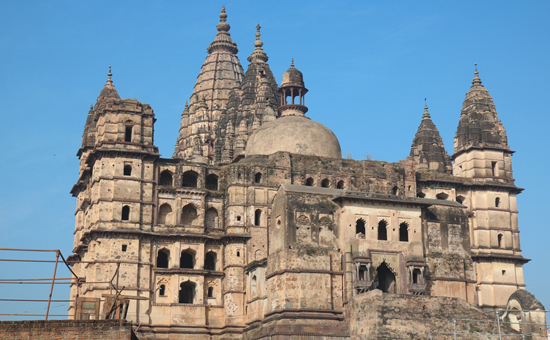 Chaturbhuj Mandir.
Chaturbhuj Mandir.
Orchha Fort Complex
A
four arched bridge leads to the fort complex on the island. There is a moat
(water body) on three sides of the fort with the fourth side being the river.
When river overflows get a feeling that the fort is an island. Must see.
“The three palaces, Rani Mahal (now Ram Raja Temple), Raja Mahal, and Jahangir Mahal have a mandala plan, i.e. square subdivided into smaller squares and rectangles with open space in the center leading to highly evolved composition and massing and play of solids and voids. These open courtyards alternating with pavilions at higher stories such that interior open spaces form an inverted pyramid structure, mark the achievement of the Bundeli architectural style, which influenced the later architecture of the whole of Bundelkhand. Source here
Jahangir Mahal was built by Vir Singh Deo in 1606 to mark the visit of Mughal king Jahangir. “The 70m square palace has a small interior courtyard with a central fountain around which are apartments and terraces in three storeys. A dome caps each corner bastion. Within the fort are numerous shrines, memorials and monuments. The architecture is a blend of traditional Hindu and elaborate Mughal. Its walls are crowned by eight domed turrets and eight slender domed pavilions, with eight more pavilions on the level below.”
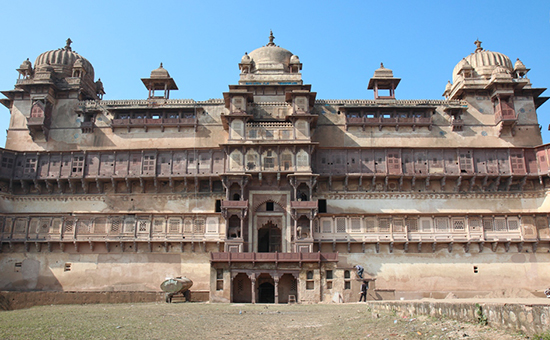 Jahangir Mahal.
Jahangir Mahal.
Raj Mahal, the second palace in the fort is well known for its murals depicting religious themes. The deeply religious Madhukar Shah built it in between 1554 and 1591. It's plain exterior, a solid single block crowned by chhatris (umbrella like memorial cenotaphs). In the Janana chamber is a huge courtyard that overlooks the Queens rooms.
In
several rooms deities as Brahma, Vishnu, the Buddha, Rama, Krishna, Sita and
Ganesh, plus Orchha royalty, wrestle, hunt, fight, dance, sit and lie their way
across walls and ceilings in vivid, colourful murals. The upper floors have
great views across the town through their pretty jali (stone lattice) windows.
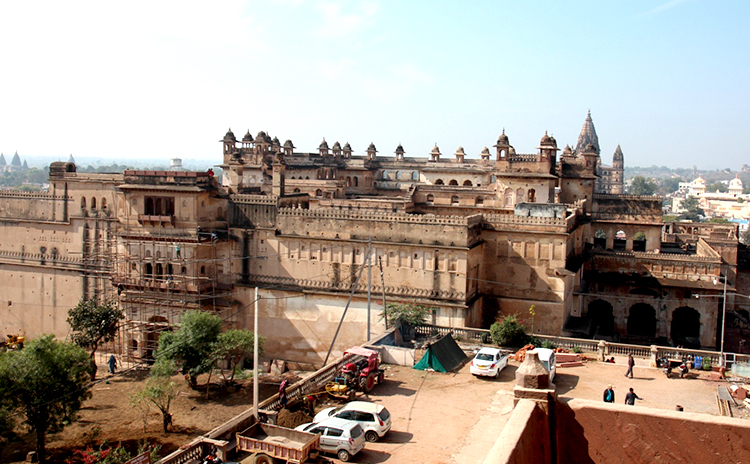 Raj Mahal, behind is Chaturbhuj T, left Chhatris, right Lakshminarayana T
Raj Mahal, behind is Chaturbhuj T, left Chhatris, right Lakshminarayana T
Rai Praveen Mahal was built for the beautiful paramour of Raja Indramani (1672-1676) who was a poetess and musician. She was a superb dancer and singer. Jahangir wanted to marry her but she refused.
Do
walk to mahal and check its murals that has Parveen in dance poses. It has a
life-size portrait of the lady, her sharp features etched out in profile, a
transparent gown showing the curves of her body.
“So famous was this courtesan that Jehangir’s father Emperor Akbar (1556 to 1605) forced her to move to his court in Agra. Parveen, however, composed a couplet for the emperor asking him why he should want to enjoy a meal that was already tasted, and earned her release to return home.”
Phool Bagh: Prince Dinman Hardol is venerated as a hero in Bundelkhand for committing suicide to ‘prove his innocence’ over a supposed affair with his brother's wife. His memorial is in Phool Bagh, a traditional charbagh (formal Persian garden, divided into quarters) adjacent to his palace, the Palaki Mahal.
“It's an animated scene here with women singing songs about him, tying threads onto the memorial's jali (carved lattice screen) and walking around it five times, making wishes they hope he’ll grant.”
Sheesh Mahal: It has become a hotel ie run by Madhya Pradesh Tourism.
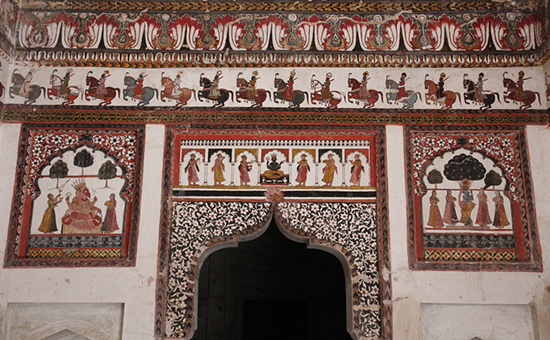 Paintings inside Raj Mahal.
Paintings inside Raj Mahal.
Light and Sound Show Fort: The show at Raja Mahal is a thrilling experience that takes you through the pages of history. It narrates the discovery of Orchha by a king whilst hunting, rise and fall of might kings, great battles, saucy romances and feats of valour.
River Rafting: If there is water in Betwa go for river rafting. It starts around Kanchan Ghat, covers about 3.5 kms through rapids and ends at Shiv Ghat. From the river you get an excellent view of Orchha’s fort and temples. Super.
Orchha
is also a great place to walk around or go cycling. You will find a lots of
locals bathing and swimming in the river Betwa.
Lakshminarayana Temple: It was built on an elevation and on a
rectangular plan by Veer Singh Deo in 1622 and renovated by Prithvi Singh in 1793.
It
fuses elements of fort architecture in temple moulds. The interiors contain
some of the most exquisite murals and walls of the Bundela School of painting.
It has paintings depicting scenes from the Ramayan & Mahabharat, fight by
Rani of Jhansi, Krishna Bhagwan ki leela.
Orchha
is famous for the Bundela School of Painting. The fort and Laxmi Narayan Mandir
have their walls and ceilings exquisitely painted.
 Lakshminarayana Temple.
Lakshminarayana Temple.
Chandrasekhar Azad Memorial is 3 kms from the City Centre. He was one of India’s well-known freedom fighters.
How to reach
Train: Mumbai
to Jhansi via Rajdhani Express. In January 2020 leaves Mumbai at 4.10 pm and
reaches Jhansi about 5 am. Delhi to Jhansi Shatabdi Express. Leaves Delhi at 6
am. Reaches Jhansi at around 11 am. From station Orchha is 16 kms. You will get
Autos and private taxis to take you there.
Air:
Closest Airport is Gwalior ie 115 kms away. Khajuraho is 163 kms away, takes
about 3.5 hours by private vehicle.
Best time to visit: October to March and during monsoons.
Recommend places to eat: Ramrajya and Betwa Tarang. Or for a home cooked thali meal call author Vandna.
Cooking Classes: Vandna also takes cooking classes, simple Indian
food.
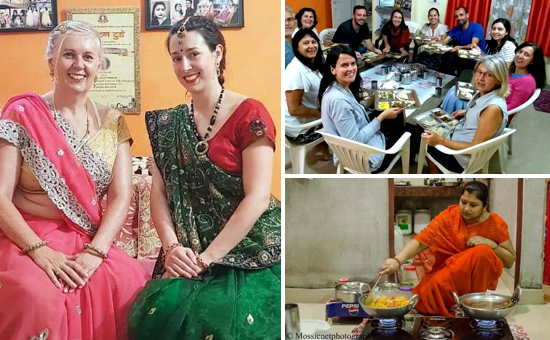 She serves guests the food she cooks.
She serves guests the food she cooks.
There
are hotels catering to various price points. Check out MP
Tourism rooms and tents here or high end is Amar Mahal. Check if the hotel Sheesh Mahal in the fort complex is available. There is Orchha Club Resort and Sunrise Hotel.
For
guide services, home stay and cooking classes email vandnadubeyorchha@gmail.com or call 91 94253 42597 or 93400 31598. Cooking pic by author, all other pictures are courtesy and copyright Sanjeev Nayyar.
To
see albums of
1.
Orchha
2.
Datia
Palace
3.
Jhansi
Fort
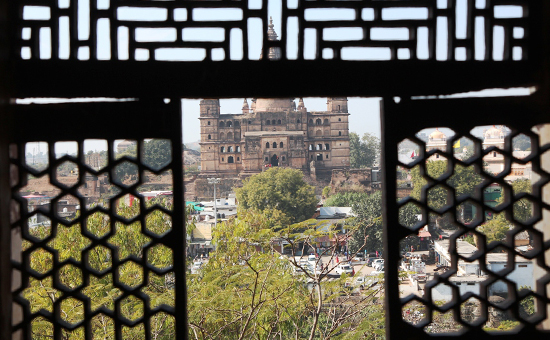 View of Chaturbhuj Mandir from Raj Mahal. U can see sanctum.
View of Chaturbhuj Mandir from Raj Mahal. U can see sanctum.